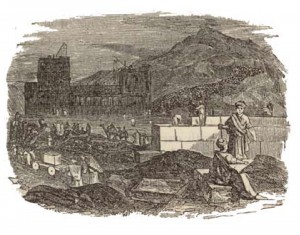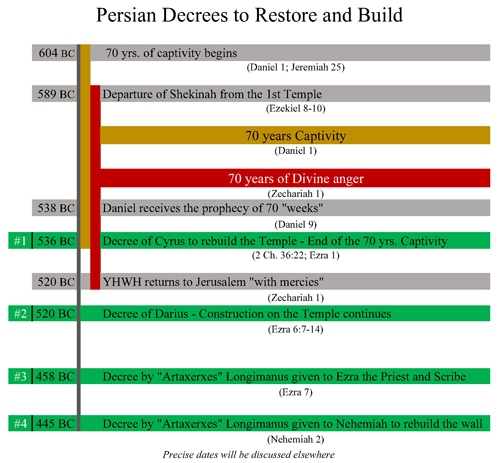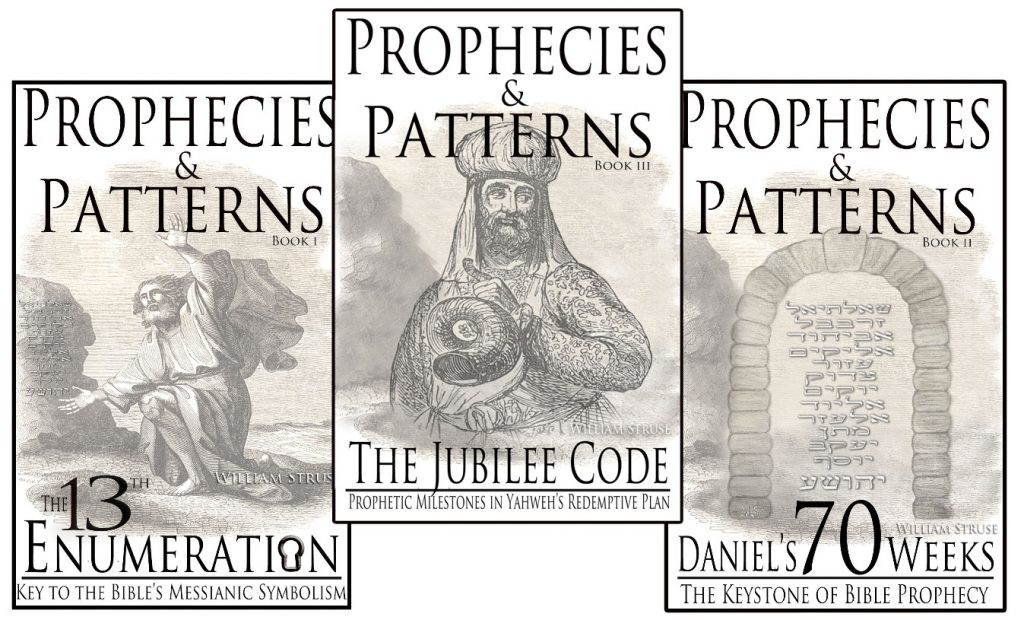 The Word to Restore and Build
The Word to Restore and Build
I don’t know about you, but if I’ve read Daniel 9:25 once, I’ve read it a hundred times. Then one day I realized that I’d never given much thought to the word “commandment” found in the text. Here take a look for yourself:
“Know therefore and understand, that from the going forth of the commandment to restore and to build Jerusalem unto the Messiah the Prince shall be seven weeks.” Daniel 9:25
The English word “commandment,” as it comes to us in Daniel 9:25, is a translation of the Hebrew word dabar. It means speech, word, speaking, utterance, etc. Of the 1439 times the word dabar is used in the KJV of the Bible, it is only translated as “commandment” twenty times. A bit curious don’t you think?
Today most scholars believe that this commandment was a decree issued by a secular Persian ruler during the Second Temple era. I mean, we all know it only makes sense for a commandment to be issued by a king, right? But what if that is only partially correct? What if we aren’t thinking big enough?
What is really interesting, when you get into the Bible’s use of the word, is that the vast majority of the time dabar is used in the Scripture it references the word, speech, or utterance of YHWH Himself. Did you know dabar is used four times in Daniel 9? It is first used in Daniel 9:2 to describe the word of YHWH that came to Jeremiah concerning the 70 years of Jerusalem’s desolation. Here, take a look:
In the first year of his reign I Daniel understood by books the number of the years, whereof the word [dabar] of YHWH came to Jeremiah the prophet, that he would accomplish seventy years in the desolations of Jerusalem. (Daniel 9:2, emphasis mine)
Dabar is next used in Daniel 9:12, and once again it references the word of YHWH. The third dabar found in Daniel 9 is in verse 23. Here the angel Gabriel explains to Daniel that at the beginning of his prayer he (Gabriel) was dispatched with the “word” of YHWH concerning the prophecy of 70 sevens.
And he informed me, and talked with me, and said, O Daniel, I am now come forth to give thee skill and understanding. At the beginning of thy supplications the commandment [word/dabar] came forth, and I am come to shew thee; for thou art greatly beloved: therefore understand the matter, and consider the vision. (Daniel 9:22–23, emphasis mine)
This brings us to Daniel 9:25 and the “commandment to restore and build Jerusalem.” Based upon the context of Daniel 9, the verse might better be read as the “word to restore and build Jerusalem.” That kind of changes the perspective, doesn’t it? For centuries, scholars have argued about which Persian ruler’s commandment begins the prophecy of 70 sevens, but few indeed have ever considered that the countdown might begin with the very words of the living God of the Bible.
Before we search for this “word,” whether it be of God or men, it will be valuable to define another word which is critical to the context of Daniel 9. That word is “restore.”
Know therefore and understand, that from the going forth of the commandment [word] to restore and to build Jerusalem . . . (Daniel 9:25a, emphasis mine)
Once again we have a Hebrew word that has a great impact on how we view this verse. The word “restore” comes from the Hebrew shuwb, and its primary meaning is to return or turn back to something that has already begun. Interestingly, shuwb is also used in Daniel 9:25b, and it is translated as “again”:
. . . and threescore and two weeks: the street shall be built again [shuwb], and the wall, even in troublous times. (Daniel 9:25, emphasis mine)
In the coming weeks as we explore the events of the Second Temple era and the Jewish people’s return to Jerusalem, keep the word shuwb in mind. This idea of turning back to something that has already begun just might help us identify the commandment or word that begins this great prophecy.
Let’s take one more look at the verse now with the primary meaning of the Hebrew words dabar and shuwb used in place of the English words “commandment” and “restore”:
Know therefore and understand, that from the going forth of the word to return and to build Jerusalem unto the Messiah the Prince shall be seven weeks . . . (Daniel 9:25a, emphasis mine)
That kind of adds a new dimension to this verse, doesn’t?
If you are still wondering why the starting point of the great prophecy even matters, consider the implications if we get it wrong. Daniel 9 is a prophecy which defines the nature and timing of a major part of YHWH’s redemptive plan for mankind. Scholars in the past several centuries have built an entire chronological framework of end-time events upon the prophetic chronology described in Daniel 9. Think about that for a moment. Did you know that the idea of a seven-year tribulation period is based entirely on an interpretation of Daniel 9 with a specific starting point in the Second Temple era? If the starting point of Daniel 9 didn’t take place when we believe it did, then how can we have any confidence that we correctly understand its ending point and all its associated eschatological implications? The truth of the matter is we can’t.
Like I said before, this is really about stewardship. YHWH had a purpose for initiating the prophecy of 70 weeks with a word to return and build. It could be a word given by a man or a word from YHWH Himself, as we have seen, but let’s not skip the first and most important step in interpreting this prophecy just because we assume we understand what YHWH meant. Instead, together as Bereans, let’s search for the answers He intended for us to find, even if those answers challenge us to look at the whole prophecy in new ways.
With these considerations in mind, let’s start by looking at the four potential Persian decrees of Daniel 9:25 and see if they have biblical merit to be considered the “word to return and build Jerusalem.”
The Persian Four
If you are at all familiar with the prophecy of Daniel 9, you probably know that scholars have traditionally pointed to four biblical commandments or decrees that potentially meet the criteria of Daniel 9:25. According to Chronicles, Ezra, and Nehemiah, all four of these decrees were given by secular Persian rulers at some point during the Second Temple era. The Persian four are as follows:
- A decree by Cyrus (the Great) in his first year (2 Chronicles 36:22)
- A decree by Darius (the Great) Artaxerxes in his second year (Ezra 6:7–14)
- A decree by “Artaxerxes” (Longimanus?) in his seventh year (Ezra 7)
- A decree by “Artaxerxes” (Longimanus?) in his twentieth year (Nehemiah 2)
To get the chronological context of these four decrees, let’s take a moment to review the chart below. The biblical decrees are listed in green relative to where they fall in the secular chronological timeline, dated according to the most widely held understanding chronology of biblical scholars today. (Whether these dates are correct or not is one of the questions we will explore in the coming weeks.) Understanding their context in the Second Temple era will helps us determine whether these four decrees are valid candidates for the “word to return and build Jerusalem.”
Never lose sight of the fact that these decrees are the foundation upon which many respected scholars build their interpretation of Daniel 9 as well as their related eschatological worldview. In fact, many scholars are so dependent on these Persian decrees for their interpretation of Daniel 9 and the 70 weeks that they have modified biblical and secular history to make them fit the prophecy of 70 weeks. Don’t get me wrong, I don’t believe this has been done intentionally. It just shows how influential well-meaning assumptions can be when they have no foundation in biblical fact. That is why we must, as good stewards of YHWH’s Word, take the time to make sure our foundation is set upon rock-solid biblical truth.
Clearly, we don’t yet have enough biblical contextual information to determine which, if any, of these decrees are the decree YHWH had in mind when He sent the prophecy to Daniel though the angel Gabriel, but that will be our purpose in the next few blog posts as we will look more closely at each one and see what biblical evidence we can gather that might help us make that determination. As our search proceeds, keep the following questions in mind:
- Could this decree be considered a dabar or word to return and build Jerusalem?
- Did this decree cause the Jewish people to shuwb (return or turn back) and build Jerusalem?
- Was this event of enough relevance to constitute “building Jerusalem”?
- Can the date of this decree be firmly established in both the biblical and secular record?
As a final thought, it essential to remember that the 70 weeks prophecy is the most important messianic prophecy in the Scripture. As such, it is only reasonable to believe that the word, decree, or commandment that begins it is of a special significance in the biblical record.
Our search for the start to the countdown to the Messiah begins with Cyrus of Persia in 536 BC. My next blog post will look at this great biblical hero.
* * *
FREE Book Download:
If you would like to learn more about Biblical history and Bible prophecy, you might also appreciate my books in the Prophecies and Patterns series.
At the following link you may download one of the three books shown below. If you like the book and would like to download the other two, all I ask is that you subscribe to my blog. I won’t share your email or spam you with advertisements or other requests. Just every couple of weeks I’ll share with you my love of Biblical history and Bible Prophecy. Should you decide you no longer wish to be a subscriber you can unsubscribe at any time.
Click the following link to download your Free book: Book Download
I hope you’ll join the adventure!
[DISPLAY_ULTIMATE_PLUS]


